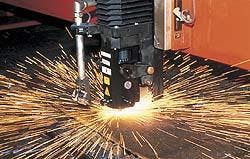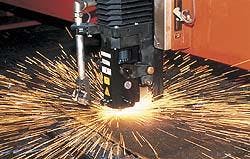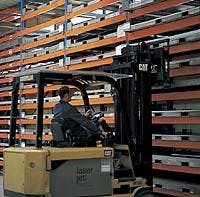Diverse cutting in a job shop
David A. Belforte
A high-speed laser cutting shop prospers with ambitious and efficient management
Ralph Thomann and two friends worked for a small job shop that did not offer much opportunity for advancement. Thomann and his friends recognized that the laser-cutting operation could be a significant business and they made suggestions to the management on how this could be accomplished. However, the company management did not agree. So doing what many ambitious people do, they left in 1988 and started their own company Laserjet 2000 AG in Bösingen, Switzerland.
They opened in a small 400m2 building located about 500 meters from their present facility. Their first order was for about $2400, after which the three partners worked from 6 PM to 7 AM on a borrowed laser cutter.
In August 1989 they installed a 1.5kW Bystronic Bylas laser cutter in their shop and began to cut sheet metal, working two ten-hour shifts per day. Business came in at a rate that allowed them to hire their first employees in December that year.
Like many laser job shops, order quantities ran from single pieces to volumes of 1000 or more. Therefore, system flexibility was key to their success. Their byword was "keep it loaded and keep it running." However, they rapidly filled up their plant capacity, and in autumn of 1990 they installed their first waterjet, a Byjet Type 2234 from Bystronic, with a single cutting head.
By 1993 the original premises became too small, so the three entrepreneurs designed and had built the new 2000m2 building. A new Bystar cutter, featuring a prototype 2.8kW CO2 laser was installed for thorough testing purposes.In 1997, Laserjet added a large-cutting-area water jet system that, coupled with the laser cutters, gave it the ability to cut almost every type of material. The big waterjet cutter is named the Bykong because it can handle material up to 6.5 m X 3 m. With these systems available, Laserjet never had to turn a potential customer away.
Business remained good and the company kept full order books such that the two laser systems were kept busy 24 hours per day seven days per week. In 1998 one large order, cutting plastics, turned out to be memorable. The massive amount of fumes (produced by the plastic being cut) that built up in the rudimentary exhaust system exploded and a fire resulted in about $570,000 damage to the plant. In the words of Thomann, "There was soot everywhere."
After this mishap, Laserjet ordered an additional laser, a 1.8kW Bysprint, now with a Bystronic filter. The company now operated three lasers. The original Bystronic 2.8kW Bysprint unit was replaced in 1999 by a new Bystar 4kW CO2 laser (see Figure 1).In 2001 the first single-headed Byjet 2234 water jet cutter was sold (after 11 years service) and replaced by the new Byjet 4022 waterjet cutter. In addition, in September of 2001 the company purchased the second Byspeed built by Bystronic. This is a high-speed cutter, powered by a 4kW CO2 laser.As visitors look down on the main shop floor from the second-level conference area they see the three Bystronic systems cheek-by-jowl. On one wall is shelving holding a large stock of sheet metal, which allows the company to quickly respond to customer shipping demands. This is important when your customer base numbers 3000 and produces 6000 to 7000 orders per year.
When asked about the purchase of the high-speed laser cutter, Thomann responds that speed is not their first consideration—power and acceleration is, although the Byspeed is great for cutting many holes. His attitude is that a job shop must be able to cut "everything or nothing." Proof of this is in the lower level of the plant where the two water jet cutters are located. Here visitors are obliged to step over large slabs of granite and marble waiting to be cut.
Buying steel in bulk reduces costs and order cycle time so that the company is able to compete with the growing number of laser cutting shops that has driven the hourly cutting costs down (see Figure 2). These practices have paid off for the company because it has been able to self-finance all equipment purchases over the years. Thomann takes pleasure in not having to deal with banks.
However, the company's ability to turn around orders in 24-48 hours, and to be able to cut all materials, is not enough to fend-off a growing number of competitors, including the company the partners used to work for. Like many shops, it has to diversify to offer customers more service. So it has added deburring equipment and installed an arc welding system.
Reflecting on the conservative approach of his former employer, Thomann stresses the flexibility characteristics of Laserjet. For example, the "night shift" is staffed by two people who work flextime. They can work any hours between 8 pm and 6 am as long as the cutting schedule is met. The Bysprint and Bystar units are run around the clock, while the new Byspeed unit runs only 8-9 hours on one shift, mainly because it is still in the test phase.
Shoehorning three systems into 560m2 might produce a little feeling of claustrophobia to visitors but it seems to work for Laserjet. Floor-to-ceiling shelves lining one wall of the main floor are loaded with 350 tons of steel and aluminum. Serviced by a forklift truck, this makes for tight working quarters. When asked about expansion possibilities, Thomann guides the visitor to the rear loading dock, pointing out that the company does have space for expansion.
More than 12 years of laser cutting at Laserjet has produced a good feel for job cost estimating. For example, jobs such as cutting 10mm-thick stainless steel are billed at $150-$190 per hour because of the high nitrogen assist gas costs. Cutting of mild steel with lower-cost oxygen assist gas, in thicknesses less than 8 mm, is typically charged $145 per hour. Thomann estimates that actual cutting time is only about 40-60 percent of a job cycle, with the rest taken up by handling.
Asked why he purchased the Byspeed when it only runs 8-9 hours per shift, Thomann points out that he is now learning just what he can do with this system. As he says, "If you don't try you don't learn." As he also says, the Byspeed cuts holes at 10 per second compared to the Bysprint's six per second. And with Laserjet, time is money.
In the conference area, showcase shelves loaded with cut samples and photos, and intricately cut samples mounted on the walls, lend credence to Thomann's claim that the company cuts everything. It's easy to see how the three partners' idea of the correct way to run a shop has paid off. Don't be afraid to try anything, and grow only when you can afford it, are philosophies that have resulted in an efficiently run and profitable laser cutting shop.
High-speed cutting systemThe Byspeed from Bystronic, with its innovative DHM drive technology, provides acceleration/deceleration up to three times that of other products. With 4.0 kW of power this means high cutting speed in sheet metal as well as the flexibility to process plate material. The Byspeed is capable of producing 600 holes per minute (0.078 inches in diameter) while holding extremely tight tolerances. The cutting table accommodates 5ft. x 10ft. sheets and allows for Bystronic's modular material handling to be added.

